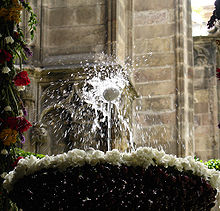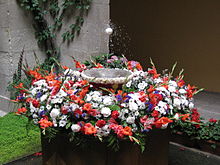- Dancing egg
-
 The dancing egg at the cloister of the Barcelona Cathedral
The dancing egg at the cloister of the Barcelona Cathedral
The dancing egg (L'ou com balla in Catalan language) is an old tradition that takes place in several towns in Catalonia during the feast of Corpus Christi. The tradition probably started at the Cathedral of Barcelona.[1]
There is evidence from the 16th century that acolytes would place a dancing egg on the fountain of the Barcelona Cathedral's cloister. The egg had been emptied and it would have some wax to fill the hole and add some weight. Positioned over the water jet from a fountain, the egg starts turning without falling. In addition, the fountain is usually decorated with flowers and fresh fruits, such as cherries with which it covers the bowl of the fountain, or broom and carnations.
From the Cathedral, the tradition also started at the patio of the neighboring Casa de l'Ardiaca (Archdeacon's House), and, from the eighties of the 20th century, at several courtyards of the Barcelona city center. In addition, other Catalan cities and towns began to do it.
In Barcelona the Dancing Egg takes place in several locations within the Gothic Quarter: Barcelona Cathedral, the Casa de l'Ardiaca, and also at other yards such as Ateneu Barcelonès, the Archives of the Crown of Aragon (Lloctinent Palace), the Royal Academy of Arts of Barcelona, Frederic Marès Museum, the cloister of the Monastery of Jonqueres (by the Puríssima Concepció basilica), the courtyards of the Centelles Palace & History Museum of Barcelona.
- In Igualada the egg dances at the Pius XII square.
- In Sitges it is found at the Maricel Museum.
- In Tarragona in 1933, the canon Dr. Josep Vallès Barceló began decorating the garden and placed a dancing egg on the fountain of the cloister of the Tarragona Cathedral. Its popularity grew, especially after the Spanish civil war, with the assistance of the authorities on the first day. At present it's prepared by a team of volunteers, a volunteer florist and the cathedral sacristy.
Bibliography
- José María de Mena. Plaza&Janes Editores, S.A. Curiosidades y leyendas de Barcelona (in Spanish), 1992, page 91. ISBN 84-01-37393-X
References
- ^ VilaWeb TV: L'Ou com Balla a Ca l'Ardiaca (Catalan)
- This article is a translation from Catalan entry L'ou com balla.
Categories:- Catalan culture
- Spring traditions
Wikimedia Foundation. 2010.




